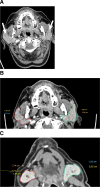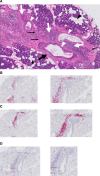Bilateral swelling of the salivary glands and sicca symptoms: an unusual differential diagnosis-Kimura's disease, a rare allergic condition with a high IgE serum level-a case report and review of the literature
- PMID: 37164447
- PMCID: PMC10173963
- DOI: 10.1136/rmdopen-2023-003135
Bilateral swelling of the salivary glands and sicca symptoms: an unusual differential diagnosis-Kimura's disease, a rare allergic condition with a high IgE serum level-a case report and review of the literature
Abstract
A 68-year-old woman presented with bilateral swelling of the salivary glands, sicca symptoms of eyes and mouth, itching, fatigue and weight gain of about 5 kg in the last 2-3 years. As part of a careful diagnostic work up including lab tests for antinuclear antibodies (ANA), antibodies to extractable nuclear antigens (ENA), anti-neutrophilic cytoplasmatic antiobodies (ANCA), immunoglobulin (Ig)G4, a whole body computed tomography (CT) and a parotid biopsy several rheumatic diseases such as Sjoegren's syndrome, IgG4-related disease and sarcoidosis were ruled out and, considering a very high titre of IgE, Kimura's disease was diagnosed. The case and a short review of the literature are presented.
Keywords: inflammation; sarcoidosis; sjogren's syndrome.
© Author(s) (or their employer(s)) 2023. Re-use permitted under CC BY-NC. No commercial re-use. See rights and permissions. Published by BMJ.
Conflict of interest statement
Competing interests: None declared.
Figures



References
-
- Sjögren H. On knowledge of keratoconjunctivitis sicca: keratitis filiformis due to lacrimal gland hypofunction. Acta Ophthalmol 1933;2:1–151.
Publication types
MeSH terms
Substances
LinkOut - more resources
Full Text Sources
Medical
Research Materials
Miscellaneous
